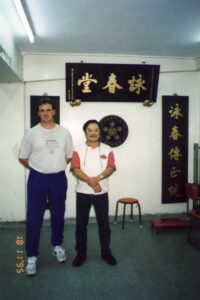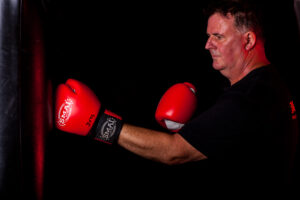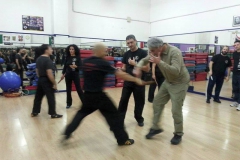
Sifu John Smith, in questo periodo, ove siamo costretti ad allenarci da soli, tutti noi rimpiangiamo gli allenamenti in palestra, gli esercizi in coppia, il Chi Sau, lo sparring e così via.
Sperando di poter tornare il prima possibile ad allenarci in palestra, ti rivolgo alcune domande sul tema delle metodiche dell’allenamento in coppia, considerando che tu hai appreso il Ving Tsun direttamente dal compianto Maestro Wong Shun Leung.

Sifu John Smith è un seguace del metodo Ving Tsun di Wong Shun Leung. Dopo essersi formato ad Hong Kong con Sifu Wong Shun Leung in persona.
È un insegnante molto preparato, completo e forte.
Presta la massima attenzione nel tramandare ai suoi studenti la tradizione del sistema così come WSL insegnava ai suoi studenti.
Per ulteriori dettagli, visita: www.wslvtaustralia.com
traduzione a cura di Maria Violeta Villaseñor
grazie sempre del tuo preziosissimo supporto
(D) Sifu Ark: Nel corso dell’ultimo seminario che hai tenuto a Roma, tutti i partecipanti hanno potuto notare le tue notevoli capacità nello sparring libero, che hai fatto con alcuni dei miei studenti, allo scopo di dimostrare come attuare le strategie di combattimento. Tutti erano entusiasti di vederti in azione. Che vantaggi porta l’allenamento allo sparring in palestra a chi vuole migliorare le proprie capacità nel combattimento reale?
(R) Sifu John Smith: Grazie Archimede, cerco di dare il mio meglio per mettere in pratica le cose, non solo la teoria.
Prima di tutto, bisogna che impariamo a combattere. Lo sparring per me è una specie di gioco e forse sono un perfezionista ma credo che il mio Sifu Wong Shun Leung sarebbe d’accordo con me. Preferisco usare il termine FULL CONTACT FIGHTING oppure COMBATTIMENTO A LUNGA DISTANZA. Delle volte, le persone rimangono intrappolate nella sfera del Chi Sau e non lo trasferiscono al full contact fighting/combattimento a lunga distanza. Quest’ultimo mette in pratica delle simili capacità ma tuttavia diverse. Bisogna allenarle! È impossibile combattere senza avere il bisogno del lavoro a lunga distanza/full contact work. Tuttavia il Chi Sau ci serve come punto di ingresso. Se non c’è il Chi Sau non esiste il Ving Tsun! Più l’allievo fa dei progressi ed apprende delle capacità più deve fare la lunga distanza. Bisogna pur sempre mantenere allenati le capacità del Chi Sau. Perché un bambino passa dall’asilo nido per poi alla fine arrivare al liceo? La stessa cosa deve succedere nel Ving Tsun.
(D) Sifu Ark: Alcuni Sifu di Ving Tsun insegnano ai loro studenti che, sull’attacco di un avversario, è meglio indietreggiare per poi tornare in avanti. Come consideri questa soluzione?
(R) Sifu John Smith: Bisogna fare un passo indietro solo se vieni sorpreso o hai bisogno di resettarti oppure se sei stato spinto all’indietro. Esaminiamo l’esercizio del Seung Ma / Tui Ma. La persona che fa il primo passo mette abbastanza pressione sul suo avversario facendolo andare indietro. E poi esiste il concetto di Lui La Hoi Song. Cioè, rimani in contatto con ciò che ti arriva ed accompagnalo fino infondo. Inoltre, c’è il concetto di Jit …intercezione… per permettere di cancellare la forza prima che si accumuli nell’avversario. Fare un passo indietro ogni volta, a prescindere dalla situazione, è come un’invito all’attaccante a picchiarti di più! Devi spegnere l’attacco prima ancora che abbia inizio.
(D) Sifu Ark: Qual è la tua idea di avanzare col passo?
(R) Sifu John Smith: L’avanzare col passo si fa per incoraggiarti a colpire usando un’insieme di massa corporale e così prendere l’equilibrio del tuo avversario. È una scarsa abilità cercare solo di “camminare” sopra il tuo avversario. Questa abilità da la possibilità di prendere l’equilibrio al tuo avversario assicurandoti di mantenere la tua propria stabilità mentre colpisci con il tuo corpo coordinatamente. Così come Wong Sheun Long ha menzionato: “muovere la testa e la coda in diverse direzioni”.
(D) Sifu Ark: So che ti sei allenato spesso nello sparring amichevole con esperti di altre discipline marziali. Quali vantaggi hai tratto da queste esperienze?
(R) Sifu John Smith: Sono 28 anni che insegno il VT di Wong Shun Leung. Negli anni sempre più persone si sono accorte di ciò che faccio. Ho avuto praticanti di: MMA, Pugilato, Karate, TaekwonDo ed altri nella mia palestra, e benché provo rispetto per il loro tipo di allenamento io ho sempre seguito i principi del WSLVT e non mi ha mai deluso. “Se riesci a farmi vedere una via migliore, voglio conoscerla”. Parole del mio Sifu.
(D) Sifu Ark: Sifu Yuen Kim Keung, il tuo Sihing (fratello maggiore di Gung Fu) ha concluso l’intervista che gli hai fatto dicendo: “Chi Sau è la pietra angolare del Ving Tsun, questo è ciò che lo rende diverso dagli altri stili”. Che consiglio puoi dare per praticare il Chi Sau applicabile al combattimento reale?
(R) Sifu John Smith: Per primo voglio citare il mio insegnante. “Non imparare il Chi Sau è come un bambino perso nella folla”. Eccellere nel Ving Tsun è capire a fondo l’allenamento che il Chi Sau ti offre.
I concetti del Chi Sau fluiscono attraverso un combattimento reale nella vita. Non devi mai trattare il Chi Sau come un semplice gioco di “acchiapparella”. Tutto ciò che fai dovrebbe avere un collegamento con il combattimento.
(D) Sifu Ark: Tu tieni seminari di Ving Tsun in tutto il mondo e alcuni Sifu di Hong Kong ti hanno più volte invitato a tenere seminari nelle loro palestre. Quali consigli puoi dare, oltre al praticare le varie forme, da allenare da soli per aumentare le proprie abilità nel Ving Tsun?
(R) Sifu John Smith: Se ti devi allenare da solo devi avere un po’ di attrezzi. Il sacco, il sacco a muro, una pallina da tennis sospesa… per citare alcuni esempi. Si può allenare il FOOTWORK, ma allenare i pugni nel vuoto, per aria, è roba da principianti. Se vuoi avere un vero potenziale per colpire, allora bisogna colpire qualcosa che ti dia del feedback. Sviluppare “la vita” è la cosa più importante e si può allenare tramite il torchio “Duen Ma” variando gli angoli ripetutamente.
(D) Sifu Ark: Quali metodi raccomandi per sviluppare il combattimento a pieno contatto (full contact)?
(R) Sifu John Smith: Prima di tutto consiglio vivamente una profonda comprensione del Chi Sau. Da lì poi potrebbero venir fuori parallelamente un po’ di movimenti a lunga distanza. Una volta che hai capito ciò, allora ti puoi avviare verso un approccio di full contact. Io uso i guanti da 8 once= 227 grammi. Non lo fate diventare una rissa! Il coach deve monitorare questo esercizio attentamente. Incoraggiate l’uso degli attributi sviluppati nel Chi Sau nell’arena del full contact. Ricordatevi di usare gli angoli di ATTACCO, togliendo l’equilibrio al vostro avversario tramite l’AVANZAMENTO DEI PASSI, il tutto proviene dal Chi Sau e si trasferisce concisamente nell’ambito del full contact. La grossa differenza è che bisogna allenare a suscitare “una reazione” nella lunga distanza.
(D) Sifu Ark: Come creare un pugno potente?
(R) Sifu John Smith: Prima di tutto bisogna fare un po’ di allenamento con i pesi per poi passare a degli esercizi più dinamici, seguiti dal sacco. Ricordatevi che il sacco al muro allena il gomito e non il pugno, tanto per dire. Invece, è proprio il sacco che ci da il feedback e che sviluppa il vero potenziale dei pugni. I FOCUS MITTS (colpitori a guantone) servono per sviluppare il tempismo e il FOCUS=CONCENTRAZIONE. Pensate in questi termini; nel Chi Sau reagiamo a reazioni non programmate. I FOCUS MITTS insieme a tutti gli esercizi dovrebbero darci le stesse reazioni non programmate.
(D) Sifu Ark: C’è qualche altro commento che vorresti condividere con noi?
(R) Sifu John Smith: Ad ogni scambio che fate, chiedetevi se in effetti sia l’approccio più semplice, diretto ed efficace possibile. Il mio Sifu Wong Shun Leung diceva che esistono tre livelli di eccellenza nel combattimento:
• Il livello più basso è quello di: bloccare e poi colpire;
• Il livello successivo è quello di: bloccare e colpire al contempo;
• Ed infine, il livello più avanzato è quello di: colpire l’avversario con una sola azione.

*** (English Version) ***
Sifu John Smith, in this period when we are forced to train alone, we all miss the workouts in the gym, exercises in pairs, Chi Sau, sparring and so on. While we await and hope to return to the gym as soon as possible, I wanted to ask you a few questions on the topic of training methods in pairs, considering that you have learned Ving Tsun directly from the late Wong Sheun Leung.
(Q) Sifu Ark: During the last seminar you held in Rome, all the participants noticed your remarkable skills in free sparring while demonstrating the use of some combat strategies with some students. Everyone was excited to see you in action! So, what are the advantages of sparring in the gym for those who want to improve their skills in combat?
(A) Sifu John Smith: Thank you Archimede. You are too kind. I always endeavour to walk the talk and not live off theory alone. Firstly we are to learn how to fight. The word sparring to me is more about a game. Maybe I am too pedantic in these words, But I am sure my Sifu would agree. I prefer to use the term full contact fighting or out of distance work. Sometimes, people get caught up in the chi sau bubble and don’t get the transfer to full contact fighting/out of distance work. Out of distance work uses a similar but different skill set. It must be practised! It is impossible to fight without the need for out of distance/full contact work. However we need chi sau to be an entry to do this. If there is no chi sau then it there is no Ving Tsun! The more the student progresses and gains skill the more out of distance work should occur. But you always need to sharpen your skills in chi sau. Why should a school child spend all their time in kindergarten when high school is the end game? The same needs to occur in Ving Tsun.
(Q) Sifu Ark: Some Ving Tsun Sifus teach their students that upon an attack from an opponent it is better to step back then go forward. How do you consider this suggestion?
(A) Sifu John Smith: To Step back is only needed is if you are surprised or need to reset yourself or if you have been pushed backwards. Let’s examine the drill of Seung Ma Tui Ma. The person that steps forward then gives enough pressure for their opponent to step back. Also there is the concept of Lui Lau Hoi Song. Stay with what comes and follow through as it departs. And also the concept of Jit…interception…to enable to cancel the adversaries force before it builds up. To step back on every attack is to invite the attacker to hit you more! You need to shut down the fight before it begins.
(Q) Sifu Ark: What is your idea on stepping?
(A) Sifu John Smith: Stepping is to encourage you to hit with a combined body mass and to take the balance of your opponent. It is very low skill level to just try and march over the top of your opponent. The skill is to take their balance while making sure you preserve your own balance while hitting with coordinated body. As Wong Shun Leung mentioned. To make the head and the tail move in different directions.
(Q) Sifu Ark: I know that you have trained in friendly sparring with experts from other martial disciplines. What advantages have you gained from these experiences?
(A) Sifu John Smith: I have been teaching for over 28 years in Wong Shun Leung Ving Tsun. Over the years more and more people are aware of what I am doing. I have had boxers, MMA, Karate, TaeKwonDo and other gung fu practitioners attend my gym. While I respect all of their training times. I have always used the principles of Wong Shun Leung Ving Tsun and it has never let me down. To use my Sifu’s own words. “If you can show me a better way, then I want to know about it”
(Q) Sifu Ark: Sifu Yuen Kim Keung, your Sihing (older brother in Gung Fu) concluded the interview you did to him saying: “Chi Sau is the cornerstone of Ving Tsun, that is what makes it different from other styles.”
(A) Sifu John Smith: What advice can you give to practice Chi Sau that is applicable to real combat? First I will quote my teacher. “To not learn chi sau is like a little boy that is lost in a crowd” To truly excel in Ving Tsun is to understand thoroughly the training that chi sau gives you. The concepts of Chi Sau flow through to real life fighting. You should never have chi sau as a game of tag. All of what you are doing should have a relationship for fighting.
(Q) Sifu Ark: You hold Ving Tsun seminars all over the world and some Sifus from Hong Kong have repeatedly invited you to hold seminars in their gyms. What advice can you give, in addition to practicing the forms, to train on your own to increase your skills in Ving Tsun?
(A) Sifu John Smith: If you are to train on your own then you must have some training equipment. Heavy bag, wall bag, suspended tennis ball are just some examples. Foot work can be practised. But to punch in the air is just for beginners. If you want to have true hitting potential then you need to hit something that gives you feedback. Development of the waist is most important this can be practised through pivoting “Duen Ma” turning and stepping off different angles repeatedly.
(Q) Sifu Ark: What methods do you recommend to develop full contact fighting?
(A) Sifu John Smith: I recommend a thorough undertstanding in chi sau first. Some out of distance work can occur in parallel at this time. Once this is is understood then you can move towards a full contact approach. I use 8 ounce gloves. Don’t let this turn into a brawl! The coach needs to monitor this closely. Encourage the attributes that you developed in chi sau into the full contact arena. Remember to use angles of attach. Taking balance of your opponent. Stepping, it all comes from chi sau and transfers over neatly into the full contact environment. The biggest difference is you need to train a response from out of distance.
(Q) Sifu Ark: How to you create a powerful punch?
(A) Sifu John Smith: First you need to do some form of weight training. Then this needs to move over to more dynamic exercises, followed by hitting heavy bags. Remember the wall bag trains the elbow and not the punch per se. It’s the heavy bag that gives us the feedback and develops true punching potential. Focus mitts are for developing timing and focus. Think of it like this. In chi sau we respond to non-planned responses, focus mitts and all of your drills should give us the same non planned responses.
(Q) Sifu Ark: Is there any other comments you care to share with us?
(A) Sifu John Smith: In every exchange you have ask your self is it the most simple, direct and efficient approach available. The late Wong Shun Leung said there were three levels of fighting excellence. The lowest level was to block and then hit. The next level was to block and hit at the same time. The best level was to hit the adversary in one action!
































